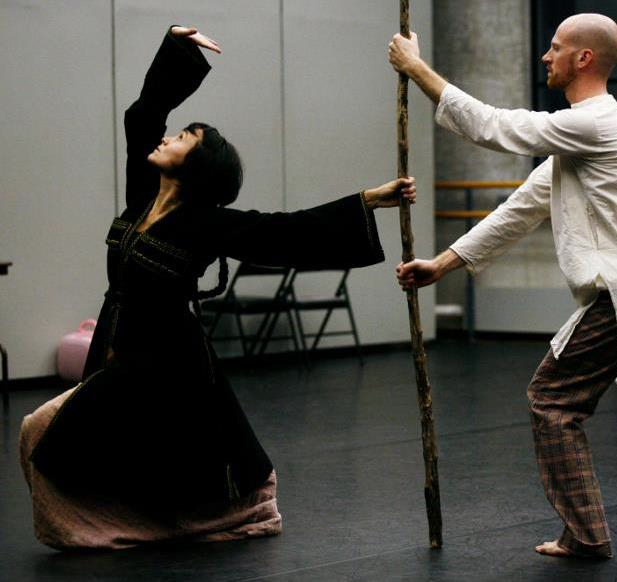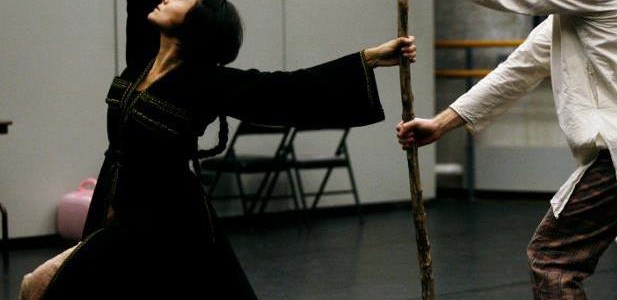“When the dancers seemed to be stuck or unable to bring an idea to life, she’d come bursting out of her chair and bust into movements that would ignite the room into flurries of activity and invention.”

Brandi Norton and Aaron Mattocks in Goats by Annie-B Parson and Paul Lazar. Photo: Julieta Cervantes.
Brandi Norton was a dancer for the Trisha Brown Dance Company from 1997 to 2006. She continues to restage projects for the company.
Q: What was your first encounter with Trisha Brown’s work?
Brandi Norton: I took a workshop with Carolyn Lucas in 1997 and that was my first encounter with Trisha’s work. I remember feeling a thousand different things, but blissfully confused and relieved above all else. Relieved because after a lifetime of rigorous containment, I could finally let go into something that made sense to my body. Confused because the act of letting go seemed impossible. Why was it so difficult? If I asked my body to let go, why would it not respond? What would I have to do in order for it to do so? How could I maintain the rigor of clear intention and virtuosic athleticism while simultaneously letting go of superfluous movements? This blissful and infuriating confusion would continue to inspire and motivate me throughout my career.
Q: What were rehearsals like?
BN: Rehearsals with Trisha were exciting, challenging, and funny. For the almost nine years that I was lucky enough to be in a studio with her, I always sought to bring my A game. She would ask simple questions that would spark inventions: “How can you stay low to the ground and stick all of your limbs out at the same time, and keep moving?” When the dancers seemed to be stuck or unable to bring an idea to life, she’d come bursting out of her chair and bust into movements that would ignite the room into flurries of activity and invention. The challenge was to remain open to possibilities while being brave enough to act on instinct and creativity. This was immensely exciting, this call and response way of creating movement. When unencumbered by self-doubt, these rehearsals were completely fulfilling.
Q: If you had one Trisha Brown dance to take with you to a desert isle what would it be and why?
BN: To dance or to watch? I would have to take two. To dance, I would take Winterreise. To watch, M.O. While one might perceive Winterreise as not having an enormous amount of dancing for the dancers to dance, in actuality there is an enormous amount of movement in it. The piece took over a year to create and went through many evolutions during that time. We began with large and loud movements that slowly got boiled down to the essence of themselves. Performing the piece was challenging because it felt essential to keep the history of each movement in there somehow. Maybe it was simply acknowledging the complexity of each movement, while striving for simplicity. Making this piece was also a deeply personal experience, where I got to know Trisha in a new way. While delving into some of the songs, we explored physical vulnerabilities that revealed personal histories. It was also incredible to be so close to Simon while he was singing! Holding him up while he was at full voice was incredibly moving. I’ll never forget being in the studio when we first ran through Die Krähe, I almost burst into tears from the power and beauty of the song and dance coming together finally. And M.O., because, well, I think it is just the most perfect dance. Jennifer Tipton said of the piece, “There is simplicity and there is chaos. Simplicity is boring and chaos is totally uninforming. And right there at that line, between simplicity and chaos is complexity. And I think that is the wonderful place that this piece exists in.” I couldn’t agree more.
Q: How did Trisha’s dances evolve during your time with the company?
BN: In the time that I was in the company, Trisha seemed to remain excited by things that were new to her. Whether it was music, technology or different styles of movement, she was always looking for ways to innovate herself and her work. I was immensely inspired by her bravery in doing so. She could have easily made dances in the same style, we all would have loved dancing them and I am sure her audiences would have loved seeing them. But she wanted to see what jazz music bring to her work, what motion-capture would bring, what Lieder would bring. Embracing these challenges demonstrated her truly post-modernist approach to artistry.
Q: What stays with you the most today?
BN: What I carry with me from working with Trisha is an openness to ideas and curiosity about the unknown. On my very first day in the company, we were working on the very last section of L’Orfeo. There was an incredible amount of complicated and difficult partnering and I was overwhelmed by it all. In a run-through that was videotaped, Trisha can be heard off-camera shouting, “Keep going Brandi!” I carry that with me always.
Brandi Norton is featured in this excerpt from L’Orfeo.

